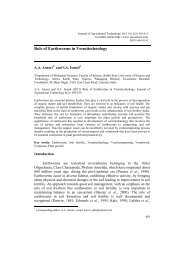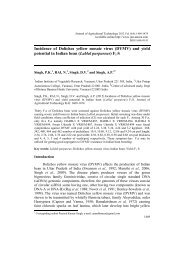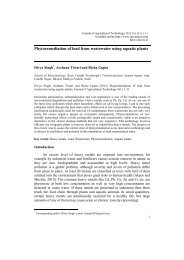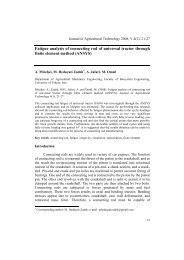Cutting energy and force as required for Pigeon pea stems
Cutting energy and force as required for Pigeon pea stems
Cutting energy and force as required for Pigeon pea stems
You also want an ePaper? Increase the reach of your titles
YUMPU automatically turns print PDFs into web optimized ePapers that Google loves.
Journal of Agricultural Technology 2011 Vol. 7(6): 1485-1493<br />
Journal of Agricultural<br />
Available<br />
Technology<br />
online http://www.ijat-aatsea.com<br />
2011, Vol. 7(6): 1485-1493<br />
ISSN 1686-9141<br />
<strong>Cutting</strong> <strong>energy</strong> <strong>and</strong> <strong><strong>for</strong>ce</strong> <strong>as</strong> <strong>required</strong> <strong>for</strong> <strong>Pigeon</strong> <strong>pea</strong> <strong>stems</strong><br />
Atul R. Dange * , S.K. Thakare <strong>and</strong> I. Bh<strong>as</strong>kara Rao<br />
Central Research Institute <strong>for</strong> Dryl<strong>and</strong> Agriculture, Hyderabad-500059, India<br />
Atul R. Dange, S.K. Thakare <strong>and</strong> I. Bh<strong>as</strong>kara Rao (2011) <strong>Cutting</strong> <strong>energy</strong> <strong>and</strong> <strong><strong>for</strong>ce</strong> <strong>as</strong> <strong>required</strong><br />
<strong>for</strong> <strong>Pigeon</strong> <strong>pea</strong> <strong>stems</strong>. Journal of Agricultural Technology 7(6): 1485-1493.<br />
The cutting <strong>energy</strong> <strong>and</strong> <strong><strong>for</strong>ce</strong> <strong>required</strong> <strong>for</strong> the pigeon <strong>pea</strong> crops were investigated. The average<br />
moisture content in the pigeon <strong>pea</strong> stem at the time of harvesting w<strong>as</strong> found to be 43 % (w.b.).<br />
Commercially available blades, sharpened at 30 0 <strong>and</strong> 45 0 bevel angle were selected <strong>for</strong> the<br />
experiment. It w<strong>as</strong> attached to the lower end of the arm of pendulum type dynamic tester, which<br />
cuts the stalk at 90 0 to the stalk axis with knife velocity ranging between 2.28 m/s to 7.23 m/s.<br />
The blade 45 0 bevel angle <strong>required</strong> 23.74 per cent more cutting <strong>energy</strong> than the blade with 30 0<br />
bevel angle <strong>for</strong> 30 mm diameter stem. Where<strong>as</strong> the blade with 45 0 bevel angle <strong>required</strong> 16.05<br />
percent more cutting <strong><strong>for</strong>ce</strong> than the blade with 30 0 bevel angle. There w<strong>as</strong> 21.65 % higher blade<br />
velocity <strong>required</strong> <strong>for</strong> 45 0 bevel angle <strong>as</strong> compared to 30 0 bevel angle blade. The study<br />
investigated that, the cutting <strong>energy</strong> <strong>and</strong> cutting <strong><strong>for</strong>ce</strong> were directly proportional to crosssectional<br />
area <strong>and</strong> moisture content at the time of harvesting of pigeon <strong>pea</strong> crop.<br />
Key words: <strong>Cutting</strong> <strong>energy</strong>, <strong><strong>for</strong>ce</strong>, pendulum type dynamic tester, moisture content, pigeon <strong>pea</strong>.<br />
Introduction<br />
Anatomical investigation h<strong>as</strong> been made on the stem of pigeon <strong>pea</strong><br />
(Cajan<strong>as</strong> cajan (L) Millsp.). The v<strong>as</strong>cular bundles of the stem are collateral <strong>and</strong><br />
arranged in a ring (Shahanara, et al., 2007). The principle of operation of the<br />
cutting element employed in any harvesting tool or equipment can be broadly<br />
cl<strong>as</strong>sified under two categories viz., (i) cutting by impact <strong>and</strong> (ii) cutting by a<br />
counter-edge. Two types of cutting mechanism, reciprocating type <strong>and</strong> rotary<br />
impact type, used <strong>for</strong> harvesting sorghum harvesting, <strong>for</strong>age harvesting,<br />
weeding, lawn mowing, etc. The latter is being incre<strong>as</strong>ingly used in these<br />
operations due to its simplicity in construction, low maintenance cost <strong>and</strong><br />
ability to but both small <strong>and</strong> large diameter stalks (McR<strong>and</strong>al et al., 1978).<br />
Effectiveness of impact cutting system <strong>as</strong> a viable alternative to the counter<br />
edge cutting is being progressively explored.<br />
<strong>Cutting</strong> using single element differs greatly from that using two opposed<br />
elements. The latter c<strong>as</strong>e is cutting with counter-edge <strong>and</strong> thus, the stalk is<br />
* Coreesponding author: Atul R. Dange; e-mail: dangeatul@gmail.com<br />
1485
supported in the vicinity of the cutting element. In this c<strong>as</strong>e, there is little or no<br />
<strong>energy</strong> w<strong>as</strong>ted in the stalk deflection be<strong>for</strong>e cutting. <strong>Cutting</strong> with single element<br />
can be referred to <strong>as</strong> pure impact cutting <strong>and</strong> depends mainly on the knife<br />
speed, cutting edge sharpness <strong>and</strong> crop inertia. Stalk resistance to bending is<br />
insufficient by itself to provide the <strong><strong>for</strong>ce</strong> necessary to oppose the knife pressure<br />
<strong>required</strong> to penetrate the material; the cutting process depends on the stalk<br />
inertia to give the <strong>required</strong> opposing <strong><strong>for</strong>ce</strong> (Pr<strong>as</strong>ad et al, 1975). Koloor et al.<br />
(2007) studied the engineering design <strong>and</strong> modification of cutting mechanism<br />
of soybean harvester. The optimum specific cutting <strong>energy</strong> value w<strong>as</strong> found at<br />
blade bevel angle 23 0 , oblique angle of 30 0 <strong>and</strong> blade velocity of 3.75 ms -1 .<br />
Reza (2007) designed <strong>and</strong> constructed a pendulum type impact shear test<br />
apparatus <strong>for</strong> paddy <strong>stems</strong> cutting <strong>energy</strong> <strong>and</strong> bale optimum parameters. The<br />
results show that blade bevel angle of 28 0 , oblique angle of 30 0 , tilt angle of 35 0<br />
<strong>and</strong> blade velocity of 2.24 ms -1 are optimum. The <strong>energy</strong> <strong>required</strong> <strong>for</strong> the<br />
cutting unit of stalk cutter may be categorized <strong>as</strong>: friction in the moving parts of<br />
the machine <strong>and</strong> air friction; kinetic <strong>energy</strong> <strong>required</strong> to accelerate the chopped<br />
material; <strong>energy</strong> <strong>required</strong> to overcome friction of the chopped material against<br />
the stationary parts of machine; <strong>and</strong> <strong>energy</strong> <strong>required</strong> to cut the stalk<br />
(O’Dogherty et al., 1986).<br />
Despite the extensive studies conducted on properties of plants, <strong>stems</strong> <strong>and</strong><br />
blade characteristics in relation to cutting per<strong>for</strong>mance (cutting <strong>energy</strong>) none<br />
w<strong>as</strong> able to provide such comprehensive relationship <strong>for</strong> thick-stemmed crops<br />
<strong>as</strong> pigeon <strong>pea</strong>, sorghum, millet <strong>and</strong> maize. There<strong>for</strong>e, an attempt w<strong>as</strong> made to<br />
investigate the cutting <strong>energy</strong> <strong>and</strong> <strong><strong>for</strong>ce</strong> require <strong>for</strong> pigeon <strong>pea</strong> <strong>stems</strong> when they<br />
were subjected to impact cutting by pendulum type dynamic tester.<br />
Material <strong>and</strong> methods<br />
The experiment w<strong>as</strong> carried out at Dr. Panjabrao Deshmukh Krishi<br />
Vidhyaptha, Akola during the year 2007-2008. A pendulum type dynamic tester<br />
w<strong>as</strong> fabricated in the Department of Farm Power <strong>and</strong> Machinery. The<br />
pendulum type dynamic tester is given in Fig.1. The line sketch (Fig. 2) shows<br />
the different <strong><strong>for</strong>ce</strong>s acting on the blade edge <strong>and</strong> pivot point in order to find out<br />
the cutting <strong><strong>for</strong>ce</strong>s in laboratory which enables to <strong>as</strong>sess the designed cutting<br />
<strong>energy</strong> <strong>for</strong> different pigeon <strong>pea</strong> stem diameter <strong>and</strong> moisture content. The<br />
physical parameters like stem diameter, moisture content, etc. of pigeon <strong>pea</strong><br />
<strong>stems</strong> were calculated through st<strong>and</strong>ard methods. The study w<strong>as</strong> conducted<br />
with three replications <strong>and</strong> four independent variables which were moisture<br />
content <strong>and</strong> diameter of stem, blade bevel angle <strong>and</strong> speed.<br />
1486
Pendulum type dynamic tester<br />
Principle of operation<br />
Journal of Agricultural Technology 2011, Vol. 7(6): 1485-1493<br />
During experiment swinging angle (θs) <strong>and</strong> θ1 were initially recorded by<br />
allowing the pendulum to swing freely be<strong>for</strong>e the crops were clamped in the<br />
vice. A pigeon <strong>pea</strong> stem of selected diameter w<strong>as</strong> first clamped in the vice. The<br />
pendulum w<strong>as</strong> then subsequently rele<strong>as</strong>ed through the same angle <strong>and</strong> the<br />
clamped crops were severed. Angle θ2 w<strong>as</strong> recorded during the process of<br />
severing. Two replications of θ2 were taken <strong>and</strong> the average value w<strong>as</strong> then<br />
found out. <strong>Cutting</strong> <strong>energy</strong> w<strong>as</strong> then me<strong>as</strong>ures by substituting the values of W,<br />
L, θ2 <strong>and</strong> θ1 in equation 1. The maximum blade velocity V corresponding to θs<br />
w<strong>as</strong> then calculated from equation 2.<br />
Construction details<br />
Fig 1. Pendulum type dynamic tester<br />
It consisted b<strong>as</strong>ically of a pendulum suspended on two ball bearings<br />
(UCS-204). It h<strong>as</strong> a fixed h<strong>and</strong> vice <strong>for</strong> holding the <strong>stems</strong>. <strong>Cutting</strong> blade could<br />
be mounted on the tip of the pendulum. On the top there w<strong>as</strong> a fixed circular<br />
aluminum plate graduated in degrees also called dial. A pointer actuated by a<br />
pin projecting from the upper arm of the pendulum showed the angle of swing<br />
of the pendulum on this graduated scale. The bench vice could be moved at<br />
right angle to the plane of the pendulum swing in order to vary the height of<br />
cut.<br />
1487
Where,<br />
1488<br />
Fig 2. Line sketch of pendulum type dynamic tester<br />
F1 <strong>and</strong> F2- Force acting at pivot (A) <strong>and</strong> at cutting point of blade (B)<br />
Distance between pivot point <strong>and</strong> centre of gravity<br />
Distance between centre of gravity <strong>and</strong> cutting point of blade (B)<br />
h1- Distance between centre of gravity <strong>and</strong> centre of gravity of pendulum at<br />
rele<strong>as</strong>ing angle<br />
<strong>Cutting</strong> <strong>energy</strong><br />
The cutting <strong>energy</strong> of the stem w<strong>as</strong> determined by the difference between<br />
θ2 <strong>and</strong> θ1 Expressions <strong>for</strong> determining cutting <strong>energy</strong> requirement <strong>and</strong><br />
peripheral knife speed were given <strong>as</strong> stated by Pr<strong>as</strong>ad <strong>and</strong> Gupta (1975).<br />
The <strong>energy</strong> dissipated in cutting a specimen in given <strong>for</strong>mula<br />
E = W L (cos θ2 – cos θ1) ........(1)<br />
Where,<br />
E = Energy dissipated, (kgm)<br />
W = Weight of the swinging part, (kg)<br />
L = Distance of centre of gravity of the swinging part from the pivot point of<br />
the pendulum, (metre)<br />
θ2= Maximum angle of deflection on the pendulum frame from vertical after<br />
cutting the specimen, (deg)<br />
θ1= Maximum angle of deflection of the pendulum from vertical at the end of<br />
free swing, (deg)
Blade velocity<br />
Journal of Agricultural Technology 2011, Vol. 7(6): 1485-1493<br />
The maximum blade velocity at impact can be determined by nothing the<br />
angle of swing between the vertical <strong>and</strong> rest position. When the pendulum<br />
weight W is rele<strong>as</strong>ed through an angle θ,<br />
V = � 2gL (1-cos θs) ……… (2)<br />
Moisture content<br />
The moisture content of the pigeon <strong>pea</strong> stem w<strong>as</strong> me<strong>as</strong>ured according to<br />
st<strong>and</strong>ard method. About 500 gm sample of stem w<strong>as</strong> kept in an oven <strong>for</strong> 24<br />
hours at 105 0 C. the loss in weight of the sample w<strong>as</strong> recorded <strong>and</strong> the moisture<br />
content in percent w<strong>as</strong> determined <strong>as</strong> in equation.<br />
Wi �Wd<br />
MC = �100<br />
Wi<br />
Where,<br />
MC = Moisture content, per cent<br />
Wi = Initial weight, kg<br />
Wd = Dried weight of sample, kg<br />
Results <strong>and</strong> discussion<br />
The three replications were taken <strong>for</strong> different cross sectional area of<br />
pigeon <strong>pea</strong> stem. The dial showed the indicated angle <strong>for</strong> cutting pigeon <strong>pea</strong><br />
stem <strong>and</strong> corresponding cutting <strong>energy</strong> <strong>and</strong> <strong><strong>for</strong>ce</strong> were calculated using<br />
<strong>for</strong>mula. In the experiment, with cutting blade (bevel angle 30 0 ) <strong>energy</strong><br />
<strong>required</strong> to cut the stem of the pigeon <strong>pea</strong> w<strong>as</strong> minimum <strong>for</strong> 8 mm diameter<br />
17.38 Nm <strong>and</strong> maximum <strong>for</strong> 30 mm diameter 141.96 Nm, where<strong>as</strong> cutting<br />
<strong><strong>for</strong>ce</strong> <strong>for</strong> the stem diameter 8 mm w<strong>as</strong> 232.5 N <strong>and</strong> <strong>for</strong> stem 30 mm diameter, it<br />
w<strong>as</strong> found 747.25 N (Table 1).<br />
1489
Table 1. <strong>Cutting</strong> <strong>energy</strong> <strong>and</strong> <strong><strong>for</strong>ce</strong> <strong>required</strong> <strong>for</strong> pigeon <strong>pea</strong> stem with 30 0 bevel<br />
angle blade<br />
Pendulum<br />
dropped at an<br />
angle, degree<br />
1490<br />
Stem<br />
diameter,<br />
mm<br />
Swing of arm from<br />
pivot with cutting<br />
angle, degree<br />
Indicated angle (degree) <strong>Cutting</strong><br />
Swing of arm from<br />
pivot without cutting<br />
angle, degree<br />
<strong>energy</strong>,<br />
Nm<br />
<strong>Cutting</strong> <strong><strong>for</strong>ce</strong>,<br />
N<br />
30 8 8 24 17.38 232.50<br />
40 12 12 32 29.48 296.80<br />
55 18 8 41 47.86 337.75<br />
70 24 5 58 100.72 709.00<br />
90 30 6 69 141.96 747.25<br />
With cutting blade (bevel angle 45 0 ) <strong>energy</strong> <strong>required</strong> to cut the stem of<br />
the pigeon <strong>pea</strong> w<strong>as</strong> minimum <strong>for</strong> 8 mm diameter 16.21 Nm <strong>and</strong> maximum <strong>for</strong><br />
30 mm diameter 188.16 Nm, where<strong>as</strong> cutting <strong><strong>for</strong>ce</strong> <strong>for</strong> the stem diameter 8 mm<br />
w<strong>as</strong> 249.11 N <strong>and</strong> <strong>for</strong> stem 30 mm diameter, it w<strong>as</strong> found 890.13 N (Table 2).<br />
Table 2. <strong>Cutting</strong> <strong>energy</strong> <strong>and</strong> <strong><strong>for</strong>ce</strong> <strong>required</strong> <strong>for</strong> pigeon <strong>pea</strong> stem with 45 0 bevel<br />
angle blade<br />
Pendulum<br />
dropped at an<br />
angle, degree<br />
Stem<br />
diameter,<br />
mm<br />
Indicated angle (degree) <strong>Cutting</strong><br />
Swing of arm from Swing of arm from <strong>energy</strong>, Nm<br />
pivot with cutting pivot without cutting<br />
angle, degree<br />
angle, degree<br />
<strong>Cutting</strong><br />
<strong><strong>for</strong>ce</strong>, N<br />
35 8 6 25 16.21 249.11<br />
50 12 10 34 35.82 340.28<br />
65 18 6 43 58.25 491.86<br />
80 24 5 62 126.45 758.34<br />
100 30 5 75 188.16 890.13<br />
Effect of moisture content on cutting <strong>energy</strong> <strong>and</strong> <strong><strong>for</strong>ce</strong><br />
It w<strong>as</strong> observed that the cutting <strong>energy</strong> <strong>and</strong> <strong><strong>for</strong>ce</strong> <strong>for</strong> pigeon <strong>pea</strong> <strong>stems</strong><br />
decre<strong>as</strong>es with incre<strong>as</strong>es in moisture content irrespective of cutting blade bevel<br />
angles (Fig. 3 <strong>and</strong> 4). The moisture content h<strong>as</strong> expressed a incre<strong>as</strong>ing effect on<br />
cutting <strong>energy</strong> <strong>and</strong> <strong><strong>for</strong>ce</strong>. Incre<strong>as</strong>ing moisture content leads to decre<strong>as</strong>ed cutting<br />
<strong>energy</strong> <strong>and</strong> <strong><strong>for</strong>ce</strong> of pigeon <strong>pea</strong> stem up to 45 % moisture content, after that it<br />
w<strong>as</strong> gradually showed reverse effect <strong>as</strong> moisture content incre<strong>as</strong>ed. Unlike<br />
phenomena in maize, wheat <strong>and</strong> paddy, cutting <strong>energy</strong> incre<strong>as</strong>es with<br />
incre<strong>as</strong>ing moisture content of stem (Pr<strong>as</strong>ad <strong>and</strong> Gupta, 1975 <strong>and</strong> Esehaghbeygi<br />
et al., 2009), in c<strong>as</strong>e of pigeon <strong>pea</strong> the relation is inverse <strong>as</strong> the pigeon <strong>pea</strong><br />
stem h<strong>as</strong> v<strong>as</strong>cular bundles of the stem are collateral <strong>and</strong> arranged in a ring<br />
(Shahanara et al., 2007).
<strong>Cutting</strong> <strong><strong>for</strong>ce</strong>, N<br />
900<br />
800<br />
700<br />
600<br />
500<br />
400<br />
300<br />
200<br />
100<br />
<strong>Cutting</strong> <strong><strong>for</strong>ce</strong> <strong>Cutting</strong> <strong>energy</strong><br />
y = 17.139x 2 - 1545.4x + 34854<br />
R 2 = 0.9725<br />
y = 58.298x 2 - 5319.7x + 121547<br />
R 2 = 0.9584<br />
0<br />
0<br />
42 42.5 43 43.5 44 44.5 45 45.5<br />
Moisture content, %<br />
Fig 3. <strong>Cutting</strong> <strong><strong>for</strong>ce</strong> <strong>and</strong> <strong>energy</strong> against moisture content<br />
of pigeon <strong>pea</strong> crop with 30 0 bevel angle blade<br />
Effect of stem diameter on cutting <strong>energy</strong> <strong>and</strong> <strong><strong>for</strong>ce</strong><br />
Journal of Agricultural Technology 2011, Vol. 7(6): 1485-1493<br />
160<br />
140<br />
120<br />
100<br />
80<br />
60<br />
40<br />
20<br />
<strong>Cutting</strong> <strong>energy</strong>, Nm<br />
<strong>Cutting</strong> <strong><strong>for</strong>ce</strong>, N<br />
800<br />
700<br />
600<br />
500<br />
400<br />
300<br />
200<br />
100<br />
<strong>Cutting</strong> <strong><strong>for</strong>ce</strong> <strong>Cutting</strong> <strong>energy</strong><br />
y = 8.7794x 2 - 783.71x + 17508<br />
R 2 = 0.9387<br />
y = 34.172x 2 - 3073.9x + 69391<br />
R 2 = 0.9749<br />
0<br />
0<br />
41 41.5 42 42.5 43 43.5 44 44.5 45 45.5<br />
Moisture content, %<br />
Fig 4. <strong>Cutting</strong> <strong><strong>for</strong>ce</strong> <strong>and</strong> <strong>energy</strong> against moisture content<br />
of pigeon <strong>pea</strong> crop with 45 0 bevel angle blade<br />
It showed that the cutting <strong>energy</strong> <strong>and</strong> <strong><strong>for</strong>ce</strong> <strong>required</strong> <strong>for</strong> cutting pigeon<br />
<strong>pea</strong> <strong>stems</strong> incre<strong>as</strong>ed gradually <strong>as</strong> the diameter of the stem incre<strong>as</strong>es from 8 mm<br />
to 18 mm. But <strong>energy</strong> <strong>and</strong> <strong><strong>for</strong>ce</strong> suddenly incre<strong>as</strong>es from stem diameter 18 mm<br />
to 24 mm (Fig.5 <strong>and</strong> 6). It may due to full maturity of plants. Full mature plants<br />
cellulose became compact <strong>and</strong> hard so the <strong><strong>for</strong>ce</strong> <strong>required</strong> to cut w<strong>as</strong> incre<strong>as</strong>ed<br />
<strong>as</strong> diameter incre<strong>as</strong>ed.<br />
<strong>Cutting</strong> <strong><strong>for</strong>ce</strong>,N<br />
900<br />
800<br />
700<br />
600<br />
500<br />
400<br />
300<br />
200<br />
100<br />
<strong>Cutting</strong> <strong><strong>for</strong>ce</strong> <strong>Cutting</strong> <strong>energy</strong><br />
y = 0.3773x 2 + 11.667x + 98.458<br />
R 2 = 0.9015<br />
y = 0.1692x 2 - 0.6336x + 11.181<br />
R 2 = 0.9902<br />
0<br />
0<br />
0 5 10 15 20 25 30 35<br />
Stem Diameter, mm<br />
Fig 5. <strong>Cutting</strong> <strong>energy</strong> <strong>and</strong> <strong><strong>for</strong>ce</strong> against stem diameter of<br />
pigeon <strong>pea</strong> crop with 30 0 bevel angle blade<br />
Effect of blade speed <strong>and</strong> bevel angle on cutting <strong>energy</strong><br />
160<br />
140<br />
120<br />
100<br />
80<br />
60<br />
40<br />
20<br />
<strong>Cutting</strong> <strong>energy</strong>, Nm<br />
<strong>Cutting</strong> <strong><strong>for</strong>ce</strong>,N<br />
1000<br />
900<br />
800<br />
700<br />
600<br />
500<br />
400<br />
300<br />
200<br />
100<br />
<strong>Cutting</strong> <strong><strong>for</strong>ce</strong> <strong>Cutting</strong> <strong>energy</strong><br />
y = 0.1463x 2 + 24.934x + 28.415<br />
R 2 = 0.9871<br />
y = 0.245x 2 - 1.4524x + 13.311<br />
R 2 = 0.9929<br />
0<br />
0<br />
0 5 10 15 20 25 30 35<br />
Stem Diameter, mm<br />
Fig 6. <strong>Cutting</strong> <strong>energy</strong> <strong>and</strong> <strong><strong>for</strong>ce</strong> against stem diameter of<br />
pigeon <strong>pea</strong> crop with 45 0 bevel angle blade<br />
<strong>Cutting</strong> <strong>energy</strong> w<strong>as</strong> a minimum at velocities of about 2.28 <strong>and</strong> 2.91 m/s -1<br />
<strong>for</strong> 30 0 <strong>and</strong> 45 0 bevel angles of cutting blades respectively. It incre<strong>as</strong>ed sharply<br />
when the velocity w<strong>as</strong> incre<strong>as</strong>ed of 3.98 m/s -1 <strong>as</strong> also reported by Yiliep et al.<br />
(2005) <strong>and</strong> Pr<strong>as</strong>ad <strong>and</strong> Gupta (1975). This may happen due to the fact that at<br />
lower velocity, impact is too less to sufficiently fail the stem <strong>and</strong> hence <strong>energy</strong><br />
140<br />
120<br />
100<br />
80<br />
60<br />
40<br />
20<br />
200<br />
180<br />
160<br />
140<br />
120<br />
100<br />
80<br />
60<br />
40<br />
20<br />
<strong>Cutting</strong> <strong>energy</strong>, Nm<br />
<strong>Cutting</strong> <strong>energy</strong>,Nm<br />
1491
equirement is incre<strong>as</strong>ed. At higher velocities, the incre<strong>as</strong>e in the cutting <strong>energy</strong><br />
may be owing to the kinetic <strong>energy</strong> imparted by the pendulum to the separated<br />
parts of the stem after cutting.<br />
Conclusions<br />
1492<br />
<strong>Cutting</strong> <strong>energy</strong>, Nm<br />
200<br />
180<br />
160<br />
140<br />
120<br />
100<br />
80<br />
60<br />
40<br />
20<br />
30 deg. bevel angle blade 45 deg. bevel angle blade<br />
0<br />
0 1 2 3 4 5 6 7 8<br />
Blade velocity, m/s<br />
Fig 7. Effect of blade velocity on cutting <strong>energy</strong> <strong>for</strong> pigeon <strong>pea</strong> <strong>stems</strong><br />
The investigation of <strong><strong>for</strong>ce</strong> <strong>and</strong> <strong>energy</strong> <strong>required</strong> <strong>for</strong> the pigeon <strong>pea</strong> stem<br />
with different treatment h<strong>as</strong> been carried out <strong>and</strong> the conclusions have been<br />
drawn <strong>for</strong>m the experiment mentioned below. <strong>Cutting</strong> speed, blade bevel angle,<br />
moisture content, stem diameter are the main constraints affecting cutting<br />
<strong>energy</strong> <strong>and</strong> <strong><strong>for</strong>ce</strong> of pigeon <strong>pea</strong> stem. Blade velocities ranging between 2.28 m/s<br />
to 7.23 m/s <strong>for</strong> cutting the pigeon <strong>pea</strong> <strong>stems</strong> of diameter ranging from 8 mm to<br />
30 mm. Effect of blade velocity indicated that the cutting <strong>energy</strong> w<strong>as</strong> a<br />
minimum at 2.28 m/s <strong>for</strong> 30 0 blade bevel angle. The dynamic cutting <strong><strong>for</strong>ce</strong> is<br />
observed to incre<strong>as</strong>e with an incre<strong>as</strong>e in the cross-sectional area in respect of<br />
samples tested. <strong>Cutting</strong> <strong>energy</strong> <strong>and</strong> <strong><strong>for</strong>ce</strong> decre<strong>as</strong>ed with incre<strong>as</strong>e in moisture<br />
content of the stem. The <strong>energy</strong> <strong>and</strong> <strong><strong>for</strong>ce</strong> <strong>required</strong> to cut the pigeon <strong>pea</strong> with<br />
30 0 bevel angle blade per<strong>for</strong>med better than 45 0 bevel angle blade.<br />
References<br />
Chancellor, W.J. (1958). Energy requirement <strong>for</strong> cutting <strong>for</strong>age. Journal of Agri. Eng.<br />
30(10):633-636.<br />
Chattopadhyay, P.S. <strong>and</strong> K.P. P<strong>and</strong>ey (1999). Effect of knife <strong>and</strong> operational parameters on<br />
<strong>energy</strong> requirement in fail <strong>for</strong>age harvesting. Journal of Agricultural Engineering<br />
Research 23(1):3-12.<br />
Esehaghbeygi, A., Hoeinzadeh, B., Khazaei, M. <strong>and</strong> A. M<strong>as</strong>oumi, (2009). Bending <strong>and</strong> shearing<br />
properties of wheat stem of Alv<strong>and</strong> variety. World Applied Sciences Journal 6(8): 1028-1032.
Journal of Agricultural Technology 2011, Vol. 7(6): 1485-1493<br />
Fisher, D.A., J.J. Kolega <strong>and</strong> W.C. Wheeler (1975). An evaluation of the <strong>energy</strong> <strong>required</strong> to cut<br />
<strong>for</strong>age crop. Agricultural Engineering (37):633-637.<br />
Koloor, R.K. <strong>and</strong> Ghaffar, K. (2007). Soybean <strong>stems</strong> cutting <strong>energy</strong> <strong>and</strong> the effects of blade<br />
parameters on it. Pakistan Journal of Biological Sciences 10(9):1532-1535.<br />
McR<strong>and</strong>al, D.M. <strong>and</strong> P.B. McNulty (1978). Impact cutting behavior of <strong>for</strong>age crops.<br />
International Journal of Agricultural Engineering Research (23):313-328.<br />
Mujumdar, M. <strong>and</strong> R.K. Datta (1982). Impact cutting <strong>energy</strong> of paddy <strong>and</strong> wheat by a<br />
pendulum type dynamic tester. Journal of Agril. Eng. Research XIX (4): 43-49<br />
O’Dogherty, M.J. <strong>and</strong> G.E. Gale (1986). Laboratory studies of the cutting of gr<strong>as</strong>s <strong>stems</strong>.<br />
Journal of Agril. Engg. Research (35):115-129.<br />
Pr<strong>as</strong>ad, J. <strong>and</strong> C.P. Gupta (1975). Mechanical properties of maize stalk in relation to harvesting.<br />
Journal of Agril. Engg. Research (20):79-87.<br />
Reza, T.K. (2007). Paddy <strong>stems</strong> cutting <strong>energy</strong> <strong>and</strong> suggested blade opium parameters. Pakistan<br />
Journal of Biological Sciences 10(24):453-4526.<br />
Shahanara, B., Islam, M.A. <strong>and</strong> Prodhan, A.K.M.A. (2007). Anatomy of the stem pigeon <strong>pea</strong><br />
(Cajanus cajan). Asian Journal of Plant Sciences 6(2):276-281.<br />
Vishvanthan, R., V.V. Sreenarayanan <strong>and</strong> K.R. Swaminathan (1996). Effect of knife bevel<br />
angle <strong>and</strong> velocity on the <strong>energy</strong> <strong>required</strong> to cut c<strong>as</strong>sava tubes. Jouranl of Agricultural<br />
Engineering Research (64): 99-102.<br />
Yiliep,Y. <strong>and</strong> Mohammaed, U. (2005). Effect of knife velocity on cutting <strong>energy</strong> <strong>and</strong> efficiency<br />
during impact cutting of sorghum stalk. Agricultural Engineering International: The<br />
CIGR E Journal Manuscript PM 05004 (7):314-320.<br />
(Received 18 April 2011; accepted 1 October 2011)<br />
1493







